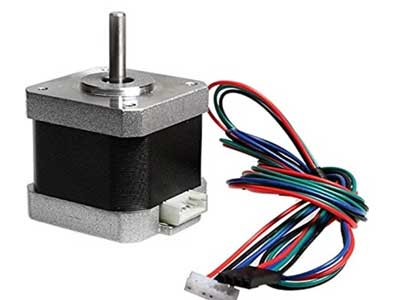What Is A Stepper Motor?
Key Takeaway
A stepper motor is an electromechanical device that converts electrical pulses into discrete mechanical movements. It operates by rotating in fixed steps, which allows for precise control of position and speed. Stepper motors are commonly used in applications requiring precise positioning, such as 3D printers, CNC machines, and robotics. They have multiple coils organized in phases that are energized in sequence, causing the motor to rotate step by step. This precise control makes stepper motors ideal for tasks where accuracy is crucial.
Definition and Working Principle of Stepper Motors
A stepper motor is a type of brushless DC motor that divides a full rotation into a number of equal steps. It moves in discrete steps, allowing for precise control of angular position, speed, and acceleration. The working principle of stepper motors is based on electromagnetism. When electrical pulses are applied in sequence to the motor windings, it creates a magnetic field that interacts with the rotor, causing it to move in fixed increments. Each pulse corresponds to a single step, making stepper motors ideal for applications requiring precise position control without feedback systems.

Types of Stepper Motors
Stepper motors come in various types, each suited to specific applications and performance requirements. The three most common types are permanent magnet stepper motors, variable reluctance stepper motors, and hybrid stepper motors.
Permanent magnet stepper motors use a permanent magnet in the rotor and are known for their high torque at low speeds. They are typically used in applications where strong holding torque is required.
Variable reluctance stepper motors do not have a permanent magnet in the rotor. Instead, they rely on the rotor’s tendency to move to the position of minimum reluctance. These motors are generally simpler and cheaper but provide less torque compared to permanent magnet stepper motors.
Hybrid stepper motors combine the features of both permanent magnet and variable reluctance types. They offer higher torque and better performance and are widely used in industrial applications requiring precise control and high efficiency.
Applications of Stepper Motors in VFD Systems
In Variable Frequency Drive (VFD) systems, stepper motors play a critical role in applications that require precise positioning and speed control. Stepper motors are highly valued in VFD systems for their ability to move in exact increments, making them ideal for tasks that demand detailed and repeatable movements.
Common applications include CNC machines, 3D printers, and robotics. In CNC machines, stepper motors ensure that cutting tools follow precise paths, enabling intricate designs and high accuracy in manufacturing processes. Similarly, in 3D printers, stepper motors control the movement of the print head and the build platform, ensuring that each layer of material is placed accurately to create detailed and complex objects. In robotics, the ability of stepper motors to provide controlled, precise movements is essential for tasks such as assembling parts, manipulating tools, and navigating environments.
In VFD systems, stepper motors contribute significantly to energy efficiency. By providing accurate control over motor speed and torque, stepper motors help optimize energy use, reducing power consumption and operational costs. This precise control is crucial in applications like conveyor systems and packaging machines, where consistent and reliable performance is required to maintain productivity and quality. Stepper motors’ ability to deliver exact positioning and smooth operation makes them indispensable in industrial automation, where precision and reliability are paramount. Their versatility and efficiency make stepper motors a key component in advancing modern manufacturing and automation technologies.
Advantages and Limitations of Stepper Motors
Stepper motors offer several advantages, making them popular in various applications. One of their primary benefits is their ability to achieve precise positioning without the need for feedback systems, which simplifies control and reduces system complexity. They also provide excellent torque at low speeds and have a relatively simple and rugged construction, which makes them durable and reliable.
However, stepper motors also have limitations. They can experience resonance issues at certain speeds, leading to potential performance problems. Their efficiency decreases at higher speeds, where they provide less torque compared to other motor types. Additionally, stepper motors can draw substantial current, even when stationary, which can lead to higher power consumption in some applications.
Understanding these advantages and limitations is crucial for selecting the appropriate motor for specific applications, ensuring optimal performance and efficiency.
Maintaining and Troubleshooting Stepper Motors
Maintaining and troubleshooting stepper motors is essential for ensuring their reliable operation and longevity. Regular maintenance includes cleaning and inspecting the motor for signs of wear or damage. Checking the motor windings for continuity and ensuring that connections are secure can help prevent electrical issues.
When troubleshooting, common issues to look for include overheating, excessive noise, and missed steps. Overheating can be caused by excessive current or poor ventilation, while noise and missed steps often result from incorrect wiring or faulty drivers. Using diagnostic tools like multimeters and oscilloscopes can help identify and resolve these issues.
Proper lubrication of the motor bearings and keeping the motor and its environment free from dust and debris are also important maintenance practices. By following these steps, you can ensure that stepper motors operate efficiently and reliably in various applications.
Conclusion
Stepper motors are crucial components in many applications requiring precise control of position and speed. Their ability to move in discrete steps allows for accurate and repeatable movements, making them ideal for use in CNC machines, 3D printers, and robotics. Understanding the different types of stepper motors, their applications, advantages, and limitations, as well as proper maintenance and troubleshooting techniques, is essential for leveraging their full potential. As technology continues to advance, stepper motors will remain integral to achieving high precision and efficiency in various industrial and commercial applications.
